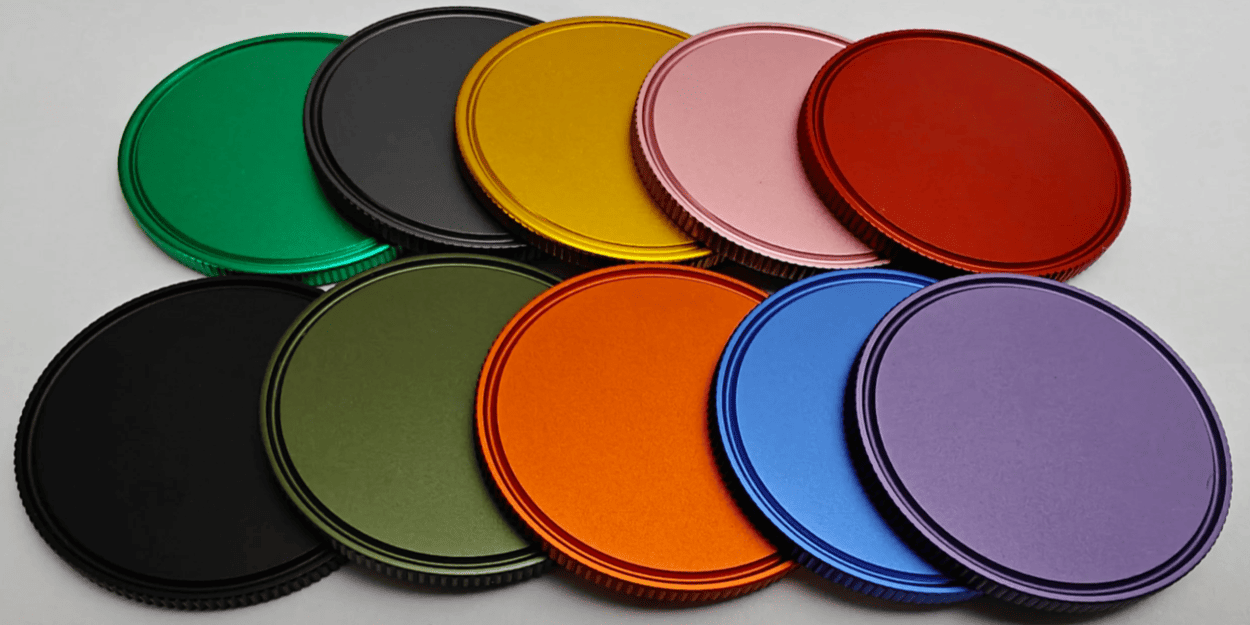Banner Image Courtesy of Umburry
What Is Anodized Aluminum?
Anodized aluminum is aluminum that has undergone an electrochemical process to thicken its natural oxide layer. And the oxide layer acts as a protective shield, making the surface harder, more resistant to corrosion, and capable of holding vibrant colors.
What to Know More:
1. Aluminum naturally forms a thin oxide layer when exposed to air. Anodizing enhances this layer for better performance.
2. Unlike paint or plating, anodizing changes the surface itself; it’s integral to the metal.
3. The anodized layer is harder than raw aluminum and won’t peel or flake.
For 3D printed aluminum parts, anodizing is often the final step to achieve both functional durability and aesthetic appeal.
How the Anodizing Process Works
1. Cleaning & Preparation
The aluminum part is cleaned to remove oils, dirt, and oxides, which ensures the anodizing process is uniform.
2. Electrolyte Bath
The part is submerged in an acid electrolyte solution (commonly sulfuric acid for Type II anodizing).
3. Electrical Current
A direct current is applied, with the aluminum part acting as the anode. Oxygen ions from the electrolyte combine with aluminum atoms at the surface, forming a thicker oxide layer.
4. Optional Coloring
The porous oxide layer can absorb dyes before sealing.
5. Sealing
The pores are sealed by boiling water or steam, locking in color and enhancing corrosion resistance.
Types of Anodizing Simply Explained
|
Type |
Process |
Coating Thickness |
Best For |
|
Type I: Chromic Acid Anodizing |
Uses chromic acid |
Thin (~0.5–2.5 µm) |
Aerospace/military parts needing minimal dimensional change |
|
Type II: Sulfuric Acid Anodizing |
Uses sulfuric acid |
Medium (~5–25 µm) |
Decorative finishes, general corrosion protection |
|
Type III: Hardcoat Anodizing |
Uses sulfuric acid at low temp, high current |
Thick (~25–100 µm) |
Industrial wear resistance, high durability |
• Type I is specialized and less common outside aerospace.
• Type II is most common for consumer products and colored finishes.
• Type III is ideal for parts that face heavy wear or need maximum hardness.
Coloring & Finishing Options
One of anodizing’s biggest appeals is its ability to add long-lasting color without compromising durability.
How Coloring Works
1. After anodizing, the oxide layer is porous.
2. Dyes are introduced into these pores.
3. Sealing locks the dye in place.
Popular Color Choices
1. Natural (Silver): clean, professional look.
2. Black: sleek, modern, hides wear.
3. Bright Colors: red, blue, gold for branding or aesthetics.
4. Custom Shades: matched to corporate colors.
Finishing Options
1. Matte Finish: Non-reflective, understated.
2. Gloss Finish: Polished, high-end appearance.
3. Textured Finish: Adds grip or visual interest.
Hi3DP Advantage: Hi3DP offers precision color matching and consistent finishes, ensuring every batch meets your design and branding requirements.
Benefits of Anodized 3D Printed Aluminum
1. Enhanced Corrosion Resistance: Perfect for outdoor, marine, or chemical-exposed environments.
2. Increased Surface Hardness: Hardcoat anodizing can make the surface as hard as ceramic, improving wear resistance.
3. Improved Aesthetics: Vibrant colors and sleek finishes elevate product appeal.
4. Better Adhesion: Paints, adhesives, and lubricants bond more effectively to anodized surfaces.
5. Thermal Performance: Anodized surfaces can dissipate heat more efficiently in certain applications.
6. Longevity: The anodized layer is integral to the metal — it won’t chip or peel like coatings.
Limitations & Considerations
1. Dimensional Changes: The oxide layer adds thickness (half penetrates inward, half outward). For tight tolerances, this must be factored into the design.
2. Alloy Compatibility: Not all aluminum alloys anodize equally well. High-copper alloys may produce uneven finishes.
3. Hardcoat Machining Difficulty: Hardcoat anodized surfaces are tough to machine post-process due to their hardness.
4. Color Fading: Bright dyes may fade over time with UV exposure.
5. Cost Considerations: Anodizing adds time and expense to production, though often justified by performance gains.
Applications of Anodized3D Printed Aluminum
Consumer Electronics
• Laptop bodies, smartphone frames, camera housings.
• Durable, scratch-resistant, and stylish.
Architecture
• Window frames, curtain walls, decorative panels.
• Weather-resistant and color-stable.
Automotive
• Trim parts, performance components, and custom accessories.
• Lightweight yet strong.
Aerospace
• Structural components, brackets, housings.
• Minimal weight, maximum durability.
Industrial Equipment
• Machine housings, control panels, fixtures.
• Resistant to wear and corrosion.
Medical Devices
• Surgical tools, diagnostic equipment housings.
• Easy to sterilize, biocompatible finishes.
FAQs
Q: What is anodized aluminum used for?
A: It’s used wherever aluminum needs improved durability, corrosion resistance, or decorative appeal — from electronics to aerospace.
Q: Does anodizing make aluminum stronger?
A: It increases surface hardness and wear resistance, but the core metal’s strength remains the same.
Q: Can anodized aluminum be colored?
A: Yes. The porous oxide layer can absorb dyes, allowing for a wide range of colors.
Q: Is anodizing safe for food-contact surfaces?
A: Yes, when done with food-safe processes. Many cookware items are anodized aluminum.
Q: How long does anodized aluminum last?
A: With proper care, anodized finishes can last decades without significant wear or fading.
Q: Can 3D printed aluminum be anodized?
A: Absolutely. Anodizing is an excellent post-processing step for 3D printed aluminum parts, enhancing both performance and appearance.














